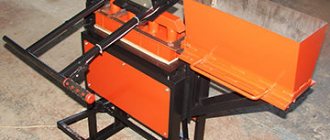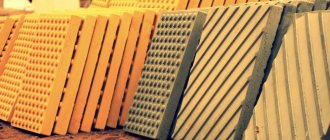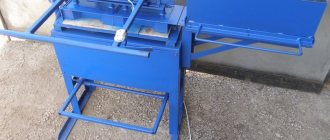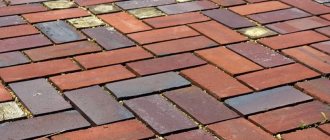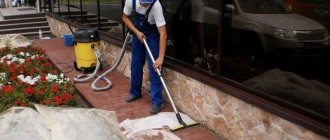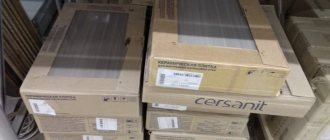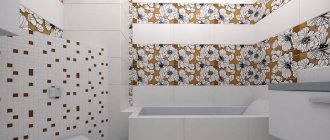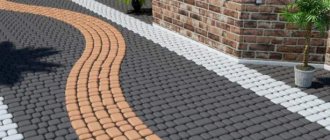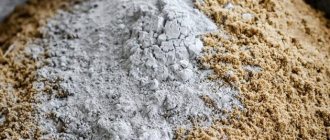A dye for paving slabs is a substance that can give the concrete mixture a certain shade. Coloring pigments are used at the production stage of paving stones, curbs or paving slabs. They allow you to obtain not dull gray tones (the natural color of concrete is gray), but products of different shapes and shades. Paving stones of different shades are widely used in the modern design of private and public areas.
Products of bright colors make it possible to create original landscape designs and decorate garden paths in summer cottages and local areas. You can also install bright elements in areas near houses and shopping centers, shops and other places. When laying paving slabs, designers skillfully combine samples of different types and shapes, creating amazing patterns.
But what dyes exist for paving slabs and which option is better to choose? Let's try to figure it out in this article.
Methods for painting tiles
There are the following methods for painting paving slabs:
- In the manufacture of paving slabs (through-painting). Dyes are initially mixed with water to form an emulsion of the desired shade. To get the desired color, you should strictly follow the instructions and make the correct proportions. When adding dye, consider the quantity and quality of the cement mixture. Products painted in this way retain their color throughout their use and do not require additional painting. But, remember that the dye consumption is high, and the financial costs will also be higher.
- Applying paint to the surface of ready-made paving stones. This method involves changing the color of only the top thin layer of the tile. By painting only the top part of the product, you can improve the appearance of the pavers and increase their lifespan. The basis for such paints are acrylic resins and other polymers that have good wear resistance. This method allows you to reduce the cost of dye, but if the tile is constantly in use, then it needs to be tinted periodically.
Types of dyes
The answer to the question of how to paint paving slabs is quite comprehensive. There are several types of dyes with different performance characteristics. Based on the method of use, they can be arranged into 2 groups:
- The agents that are introduced into the internal structure of the t are coloring substances added during the manufacture of tiles.
- Compositions that have a surface effect. Those with which the finished surface is processed.
Painted sidewalk at the dacha Source www.kraski.ru
Price
There are many types of coloring mixtures available in the market. On sale you can find pigments for concrete from domestic and foreign manufacturers. Buyers can buy paint of a certain color and in the right quantity without much difficulty. But the price for such goods is different. The cost of dyes depends on several factors:
- Manufacturer.
- Type and color of color.
- Pigment weights.
You can buy inexpensive but high-quality pigments or purchase expensive but proven dyes.
Main characteristics of the dye
Due to the fact that the street surface of paths is exposed to various physical and chemical influences, pigment dye for paving slabs must meet the following requirements:
- • maintain its color under the influence of ultraviolet rays and precipitation;
- • do not dissolve in water;
- • have a high degree of resistance to alkaline environments.
It is recommended to limit the amount of color additives added to the following range:
- • for gray cement 1 - 7% by weight used in the binder solution;
- • for white cement 0.1 – 6% of the amount used in the binder solution.
In this case, they will effectively fulfill their purpose. But when deciding how much dye for paving slabs to add when mixing, you need to take into account that with its excess, you will have to add more water to the solution, since it is not recommended to lay it dry. But it’s also not worth trying to reduce the consumption of dye for paving slabs, since its concentration determines how rich and durable the resulting color will be.
How to make colored tiles with your own hands?
You can get exclusive products by making them yourself. In this case, when deciding which dye to add to paving slabs, it is better to give preference to inorganic pigments, with the help of which you can obtain products of the most unusual colors. It is also worth considering that no matter what dye you choose for your homemade tiles, it will best color white cement. When gray cement is used in a solution, the quality of the color decreases, since it gives the product a dirty tint. But this does not apply to highly saturated colors (red, yellow, green, blue); any cement is suitable for their production.
In addition, regardless of the quality of all components of the solution, when making products for street coverings, a plasticizer should be added to the mixture. This essential ingredient is available in the form of a yellowish powder. With its help, you can significantly reduce the time that is usually required for the mortar to harden and reduce the water absorption of cement. The required amount of coloring additives will have to be selected using the “sampling method”, starting with 30 grams of powder. Before adding a plasticizer and a dye for paving slabs to the mixture, they are diluted in a small amount of water to obtain a suspension.
The resulting liquid is poured little by little into the solution, stirring continuously. After 5 minutes the composition acquires a uniform color. It is by this and the absence of lumps that the readiness of the composition for molding is determined. Within a day, the finished products can be removed from the molds. In some cases, if you want to save money on tinting additives, you can make a two-layer mold filling by laying the colored mixture as the first layer, and an uncolored solution on top of it.
Making colored tiles with your own hands allows you to reduce the cost of landscaping, as well as independently design paths in the garden in a unique style.
Staining technique
Preparatory stage
Before you begin applying paint, you should clean the surface of the tile from contaminants. Any dirt can be easily removed with a brush and water. To obtain a better effect, you can use synthetic detergents or a regular soap-based solution. When cleaning the surface from dirt, it is not advisable to use too much water pressure, as this can wash sand out of the cracks between the tiles, which will reduce their strength.
To remove moss, use a brush. To prevent them from appearing again, it is advisable to periodically treat the surface with herbicides and various lawn mixtures. If you decide to use hydrochloric acid for cleaning, then after completing the procedure you need to rinse it off with plenty of water. Otherwise, colored spots may appear on the surface.
Residues of gasoline or diesel fuel should be removed with strong solvents such as solvent or white spirit. After the surface of the tile has dried, a primer is applied to it. This is especially true when working with a porous base.
Applying paint
Traditionally, rubber paint is not thinned. It is applied to the surface using a special brush, roller or spray. All work must be carried out at temperatures above five degrees. To obtain the most dense coverage, it is necessary to apply several layers of the composition. Each subsequent layer should be applied only after the previous one has dried.
If cracks appear on the surface to be painted, these areas are painted over with a brush. Typically, each layer dries within three hours, although drying time depends on temperature and humidity. In addition, the instructions for the composition indicate individual drying times. All tools you work with must be rinsed with cold water before they dry.
Painting when laying tiles
Paint has already been added to the tiles.
The painting process in this version is slightly different from the previous one. First of all, the difference lies in the labor intensity of the process. But besides this, you need to know the technology itself. Painting tiles is not an easy task, so you should take this process seriously.
In addition, evaluate the pros and cons of the future process; the conclusions drawn will help you make a decision both in favor of painting and in favor of paving without painting.
Polyurethane paint
Using polyurethane paint
This type of paint is also intended for a protective effect. It copes well with temperature fluctuations. Its characteristics are very similar to previous options:
- Increased wear resistance;
- Strength of the material;
- Acquiring resistance to chemical elements;
- Endurance against weather changes;
- Increased viscosity.
When using this paint option, you should remember one thing: when painting outdoors, the color shade may change, but the functions of the material will remain unchanged.
We paint correctly
Preparing to paint tiles
Each type of paint has its own characteristics and nuances when applied to the base. Usually all the features are indicated on the packaging material.
The first layer of any paint must be painted with paving slab pigment diluted with turpentine. This will speed up the drying process. To perform painting work, use a short-haired roller.
For the remaining layers of the coating, use regular dye. To achieve a rich shade, three layers are enough.
Types and brands of tile dyes
Powder dyes are sold in bags. The cost of chemical dyes ranges from 65 to 120 rubles per bag. The price in this case will depend entirely on the color. Pigments of the red-orange palette will be the cheapest, while blue or purple powder will cost an order of magnitude more - 100 - 110 rubles per kg.
This difference in price is due to the fact that all of these dyes are based on iron oxide , which has an orange-red color. Thus, the manufacturer does not need to attract additional investments to create this kind of shades. When producing green or blue dyes, additional pigments are added to the solution, giving the powder the required color.
The most famous manufacturers of dry coloring powders are (Germany) and Omnikon (Denmark). The price range of the German company ranges from 80 to 430 rubles per kilogram. The Danish company offers consumers to purchase coloring pigments at a price of around 130 rubles (green color is not sold).
It should be noted that liquid paint (polyurethane or rubber) does not cost much less. For example, the Russian market sells rubber paint at a price of 180 rubles per kilogram. Alkyd paint is one of the cheapest, it can be purchased at a price of 50 rubles/kg.
The process of preparing paving slabs for painting
- The very first thing to do is clean the surface of the coating. This process involves not only removing debris, but also sweeping the surface. It is better if you use a vacuum cleaner instead of a broom.
- The second stage of preparation is that the paving surface is moistened with water. This can be done either with a garden hose or with special equipment. After wetting, the surfaces must dry.
- The third stage is the dyeing process itself.
Pros and cons of coloring
Let's look at the positive aspects first:
- The painted surface of the tile is less susceptible to environmental factors such as high humidity or temperature fluctuations, destructive winds or ordinary mechanical damage.
- The surface is less slippery.
- Protection of tiles from destruction and aging during prolonged use.
- Possibility of changing external landscape design data.
- To sum up all of the above, painting the tiles will lead to a long service life and additional durability of the coating.
Negative aspects include:
- The dyeing process is quite labor-intensive and lengthy.
- The need to touch up frequently used areas.
- Danger of toxic poisoning during the dyeing period.
Painting paving slabs
If you consider all the arguments, both negative and positive, you can come to the conclusion that you still need to paint the surface, but you can try with the negative aspects, or partially eliminate them. For example, at the time of dyeing, use a special mask to avoid poisoning.
Alkyd dyes
This type of dye is more suitable for protecting paving slabs. Its properties allow you to protect:
- from chemical exposure;
- from the influence of precipitation;
- from temperature fluctuations.
All these properties primarily protect the tile from premature destruction, from the release of salts on the surface, and also allow increasing resistance to various types of loads.
Alkyd dyes are characterized by:
- increased resistance to the effects of chemicals and precipitation on the material.
- Protection of sidewalk coverings from destruction during short periods of operation.
But besides the advantages, there is also a disadvantage:
- This is a specific smell of a material that retains its effect for a long time.
Color mixture for the first layer
As a recommendation
Painted paving slabs in the garden
If you decide to paint paving slabs in your garden, then choose a favorable moment when the weather conditions are most suitable.
Consider the properties of the chosen paint; many types cannot be used at temperatures below +10 0C. And also pay attention to the upcoming weather; if precipitation is expected, postpone painting to another time.
The weather should not be windy, as it will not allow you to efficiently clean the sidewalk from dust and debris. If the paths are already covered with paint, then the swept debris will stick to the coating.
If the area to be painted is not very large, then you can use an awning to protect it from weather conditions; polyethylene can be used as walls.
Whatever type of coating is laid on your site, you can always change it with the help of paint for paving slabs. This solution will make your site unique.
Rubber dyes
A type of rubber tile
. This type is a fairly new material in the construction world. If we compare the quality of its coloring with the finished colored tiles, then it is in no way inferior to it. The characteristics of this coating contain several points:
- High fire-resistant property.
- Increased wear resistance, including resistance to ultraviolet rays.
- Not subject to deformation due to temperature fluctuations. These factors do not affect the color of the coating.
- The material has no specific odor.
- It is absolutely not harmful to humans and provides a non-slip surface for paths.
- Has high elasticity.
- Has waterproof properties.

